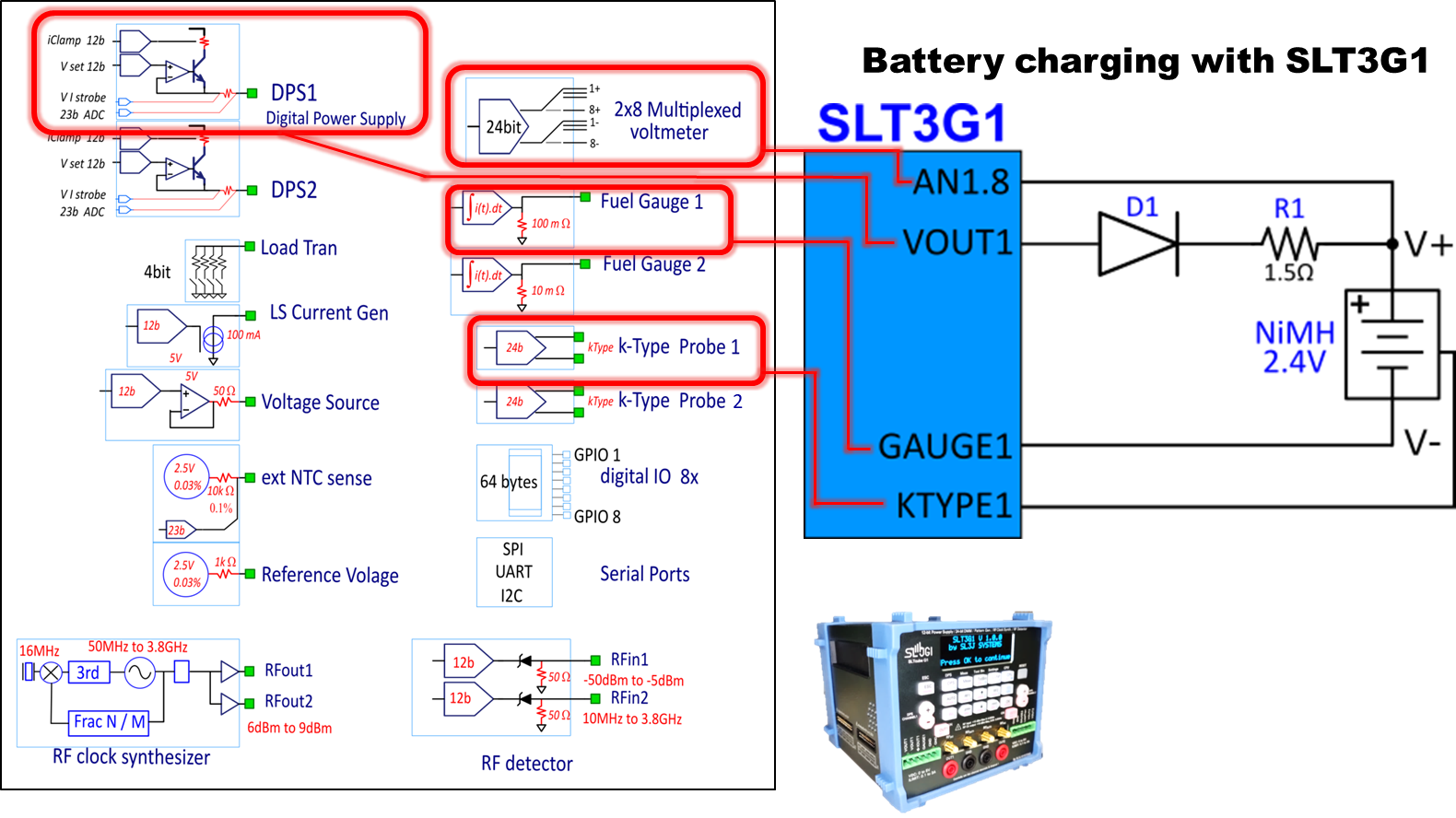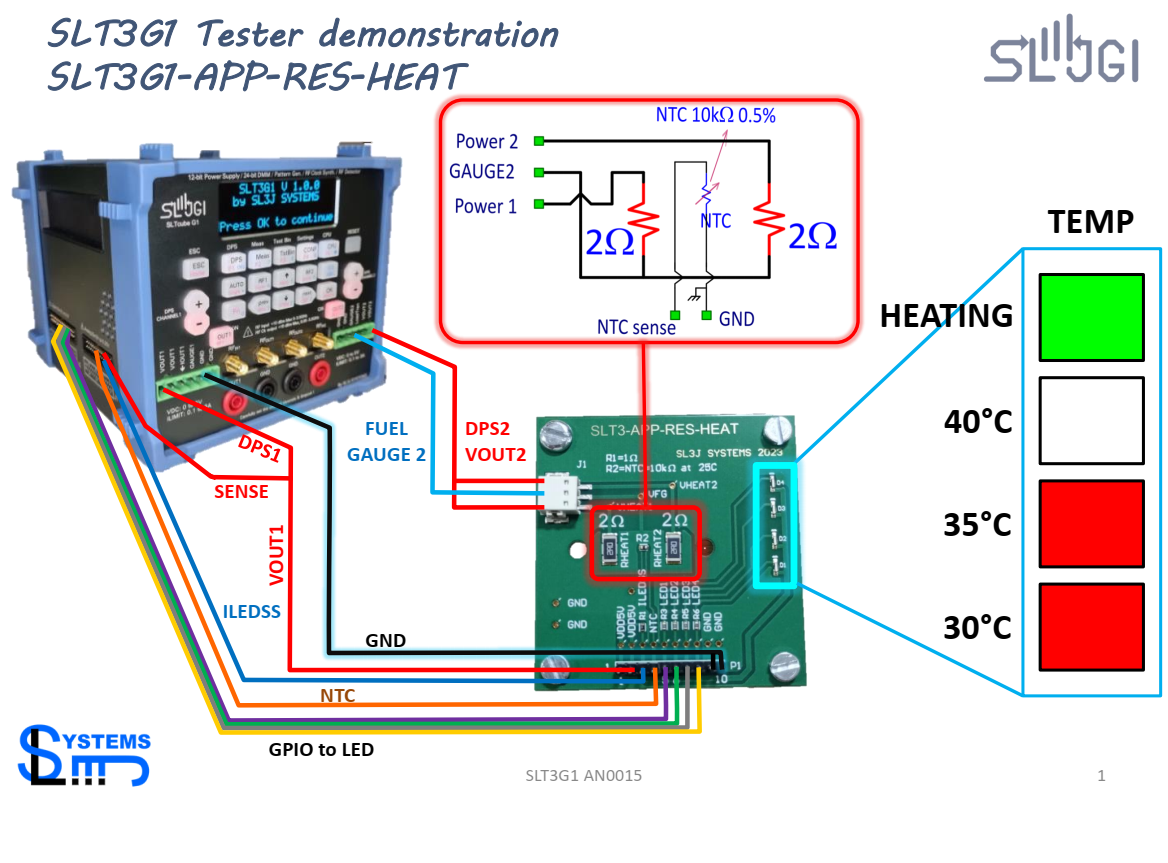Application Notes AN0013:
SLT3G1 used to monitor NiMH battery cahrging

Abstract:
Application Notes providing a demonstration of NiMH battery charging by using the All-in-One Electronic Tester SLT3G1™ .
It provdes details about the test script and test results of a NiMH battery charging implementing up to 6 criteria for detecting the End of Charge state : V(EoC), fault Temp, dTemp/dt, measured capacity using the Fuel Gauge, stop at estiamted max charging time, detec reverse or flat dV/dt at EoC
Hardware Requirements:
- SLT3G1 All-in-One tester
- 2S NiMH battery case
- Aligator connectors
- Wiring as per the schematic above
Audience:
- Silicon Validation, Application Engineersengineers,
- Test technicians, operators, white room operator
- Teachers, Researcher, graduate students

Documents
Algorithm used




AN0013 in details
Experiment Setup
Following the above schematic:
- Connect diode D1's anode to VOUT1 (front face of SLT3G1)
- Connect VBAT- sense resistor terminal to GAUGE1 (front face of SLT3G1)
- Connect VBAT+ sense resistor terminal to ANA1_IN8 (J1.23, left face of SLT3G1)
- Plug a kType probe to PROBE1 (rear face of SLT3G1)
- Position the kType thermocouple probe on the battery pack (isure it is electrically isolated)
Required HW, FW, and SW tools
- SLT3G1 all-in-one electronic tester
- SLTcube01_FW release 0.9.6 or later
- SLTcubeUX01 release 1.9.2 or later
- SLRTOSmvcG1 release 1.9.2 or later
Description
In this application note, we are charging a pair of 1.2V 2000mAh NiMH cells at a regulated current.
BAT+ is connected to VOUT1 and BAT- is connected to GAUGE1.
The charging current is adjusted with DPS output voltage increments/decrements until reaching the specified charging current (e.g. 600mA).
Finally, the charging process is automatically ended when the end of charge is detected.
Thanks to SLT3G1's powerful real-time operating system SLRTOS01, we only need to create two tasks to make this experiment:
- A static task used as Timer payload named REG600MA:
It measures battery voltage and adapts DPS settings to keep a constant charging current until End Of Charge detection - A volatile task that initializes the tester and launches a Timer payload
Two methods of end of charge detection are presented below:
- The first method is a simple current accumulation monitoring, where the accumulation current is checked regulary until reaching/exceeding a soft limit (e.g. 1200mAh). This value is set by the user and considered as the amount of charge needed to reach the End Of Charge. Thus, one should be careful when settings this value to avoid overcharge (Does the experiment start with an empty battery ? What is the battery max capacity ? etc).
- The second method is a derivative of Negative Delta V (NDV) detection. A small voltage drop is exepcted at the end of charge of an NiMH battery but is only of a few mV/cells (especially at low C rate). Therefore, we will rather focus on voltage plateau and inversion of the voltage slope. The current battery voltage is compared to the max battery voltage. If the current Vbat is consecutively lower than Vbatmax for a significant amount of times (e.g. 100 measurements), we consider that the End of Charge has been reached.
The scripts provided in this document are suited for FW version 0.9.6 and OS version 0.8.1.
These scripts are intended to be used with copy/paste directly in the script editor.
Feel free to contact us to get the SLRTOS code in .json format?
Advanced Scripting with SLT3G1
Advanced SLT3G1 scripting to Implement a Combination of EOC criteria
–EOC when when max Temp = 45°C
–EOC when pack Open Circuit Voltage = 3.0V (2 cells)
–Voltage Plateau or sligh negative Delta V at EOC
–dT/dt (>1°C/min)
–Fuel gauge / coulomb counter limitation by user set
–Charging Timeout condition as extra-security criterion
Implement a 0.3C constant current charging
- Using DPS1 Digital Power Supply
- Iterate set Vout/measure Vout, Iout
- Increase of decrease Vout depending on Iout – Iset while not EOC
Similar Applications

Metal Electroplating
The same algorithm of battery charging can be exploited to generate complex current source waveforms with SLT3G1, and develop advanced techniques for Metal Electroplating experiments
With only one instrument (SLT3G1):
- Generate voltage waveform
- Regulate current
- Measure and monitor current
- Measure solution temperature
- Count electrons / calculate metal weight and thickness
- Create timeout conditions
- Wait for temperature regulation





